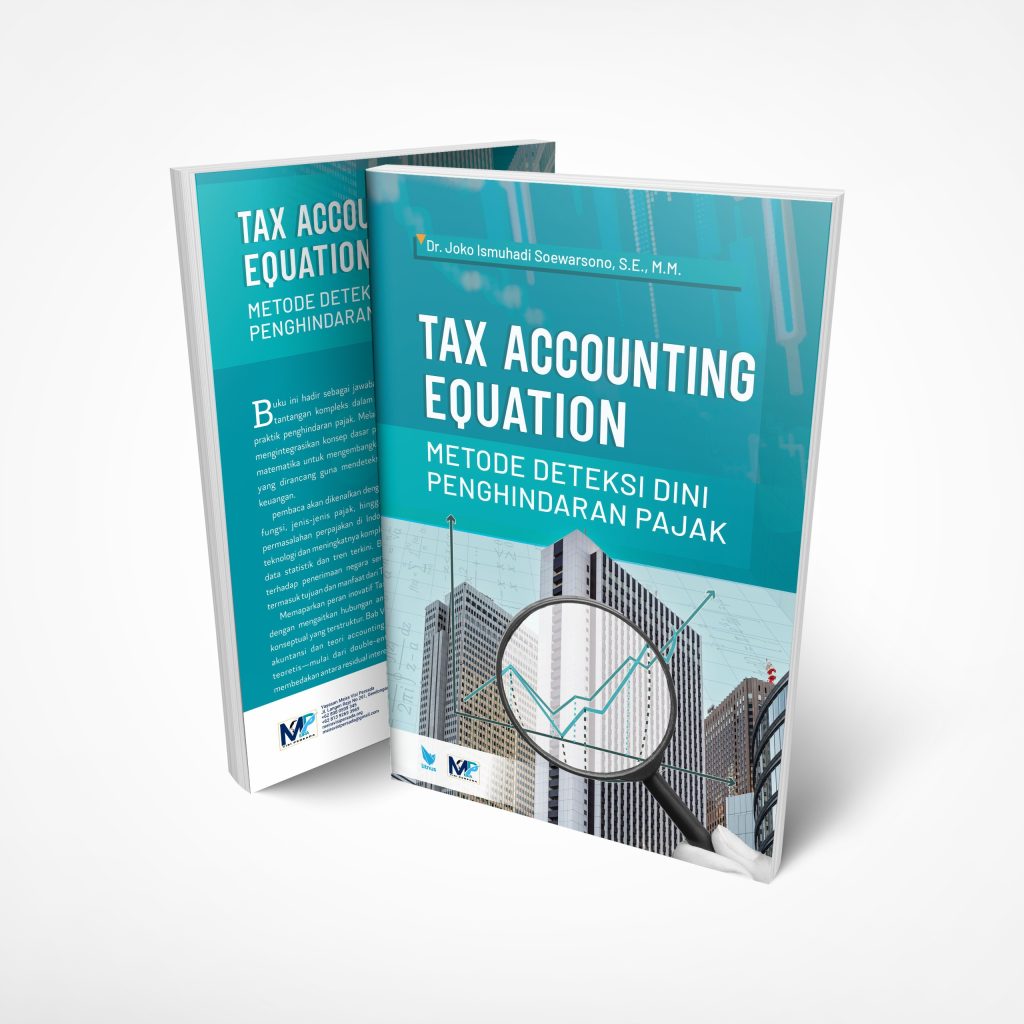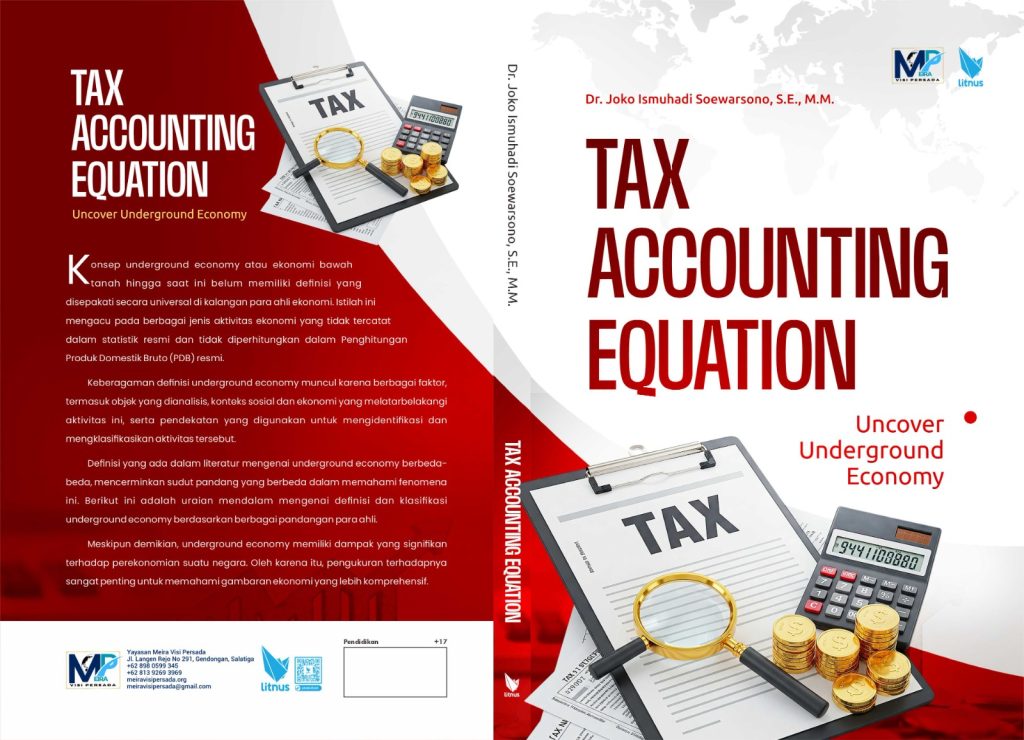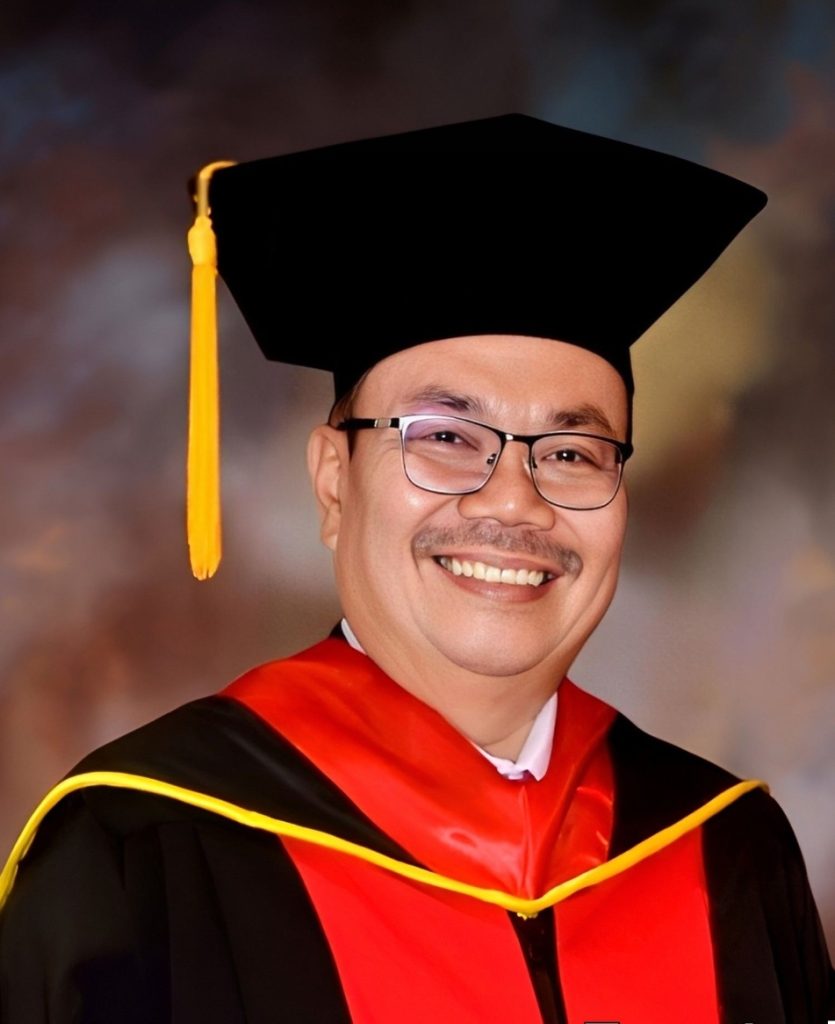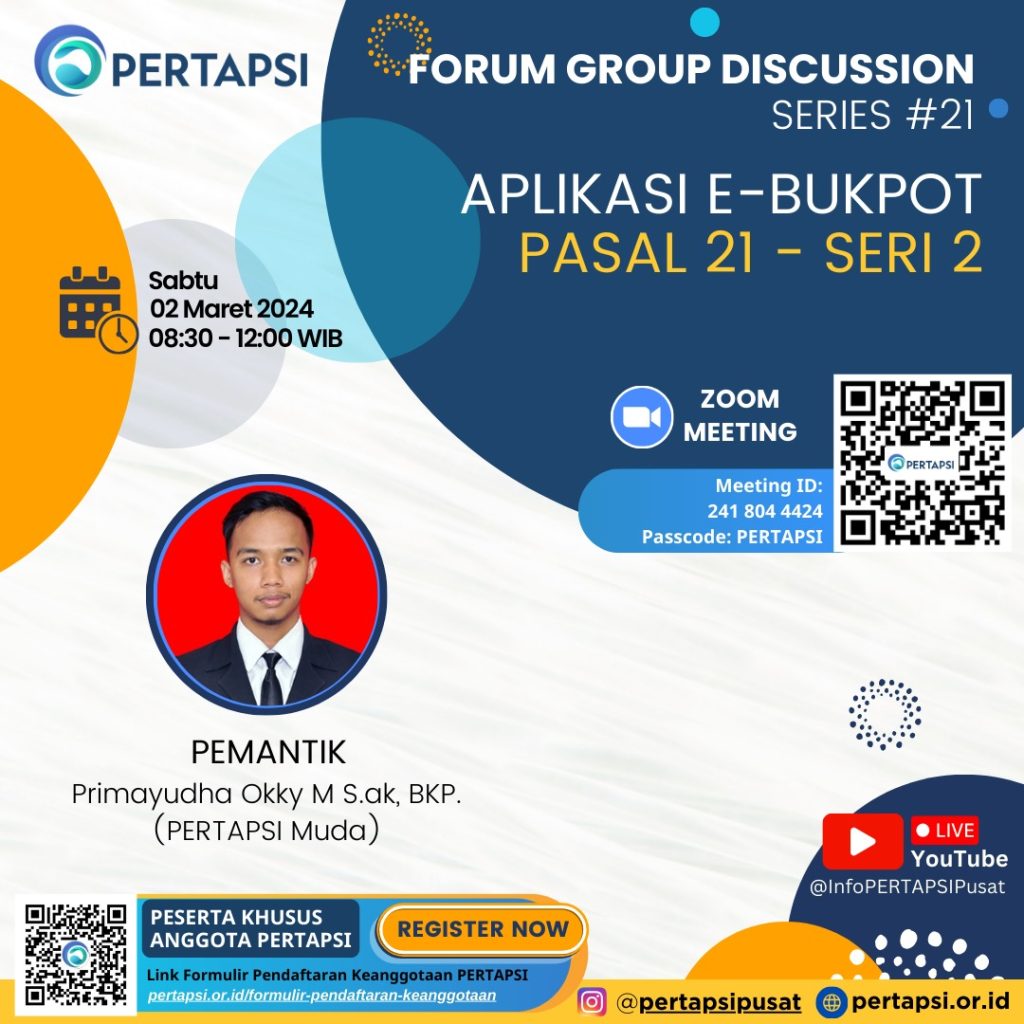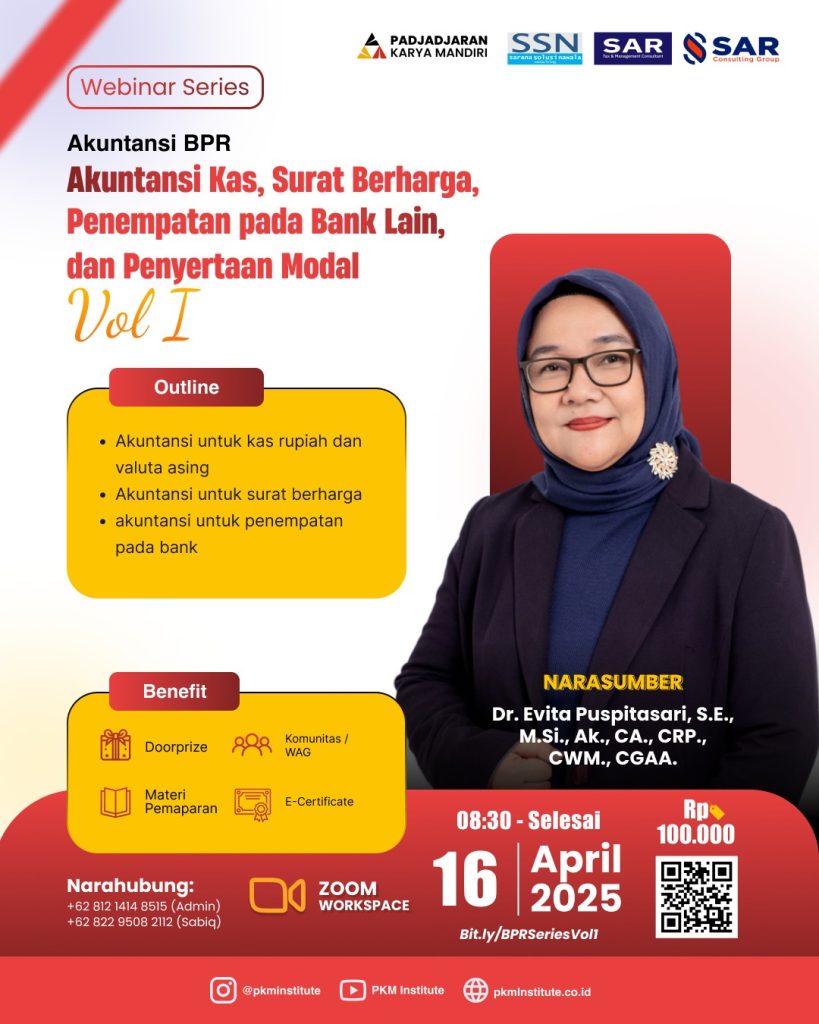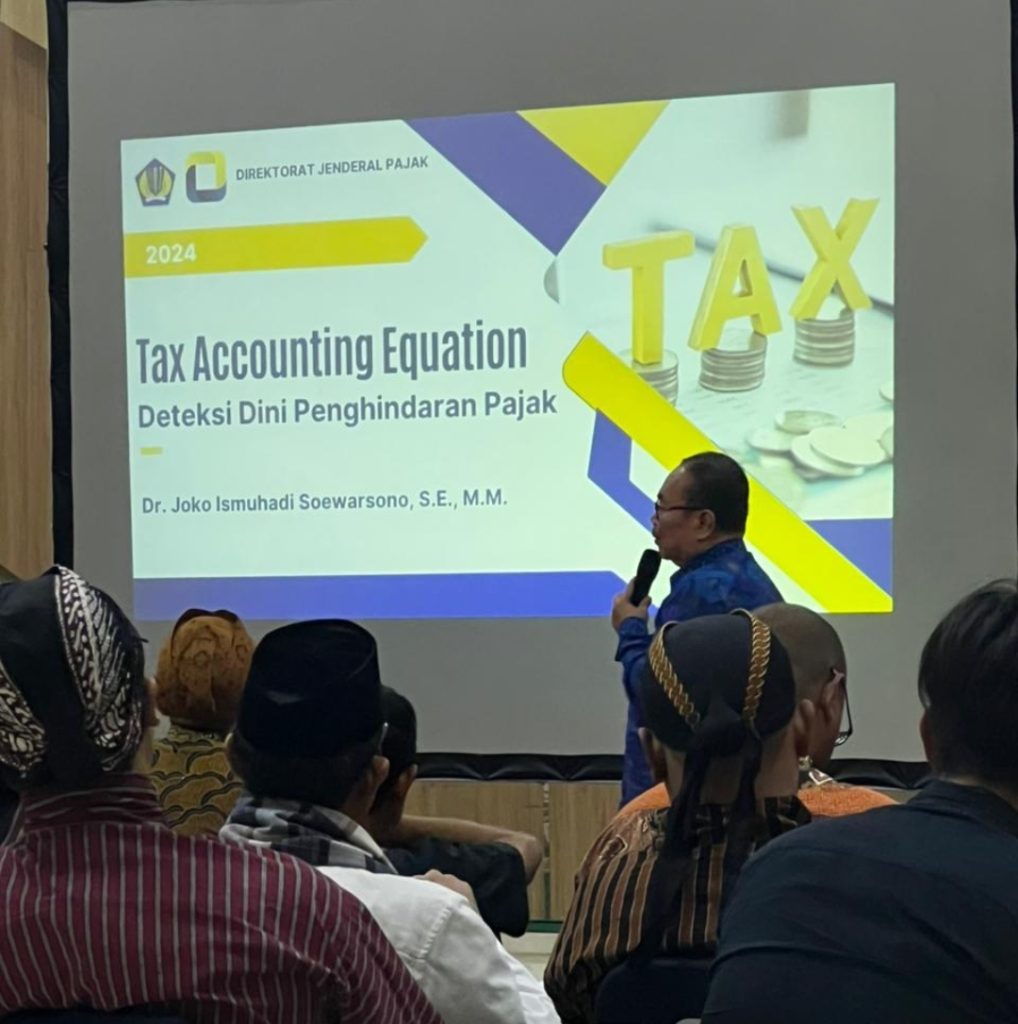
The Tax Accounting Equation: A Forensic Tool for Enhanced Tax Enforcement in Indonesia
- Ekonomi
Saturday, 26 April 2025 15:48 WIB
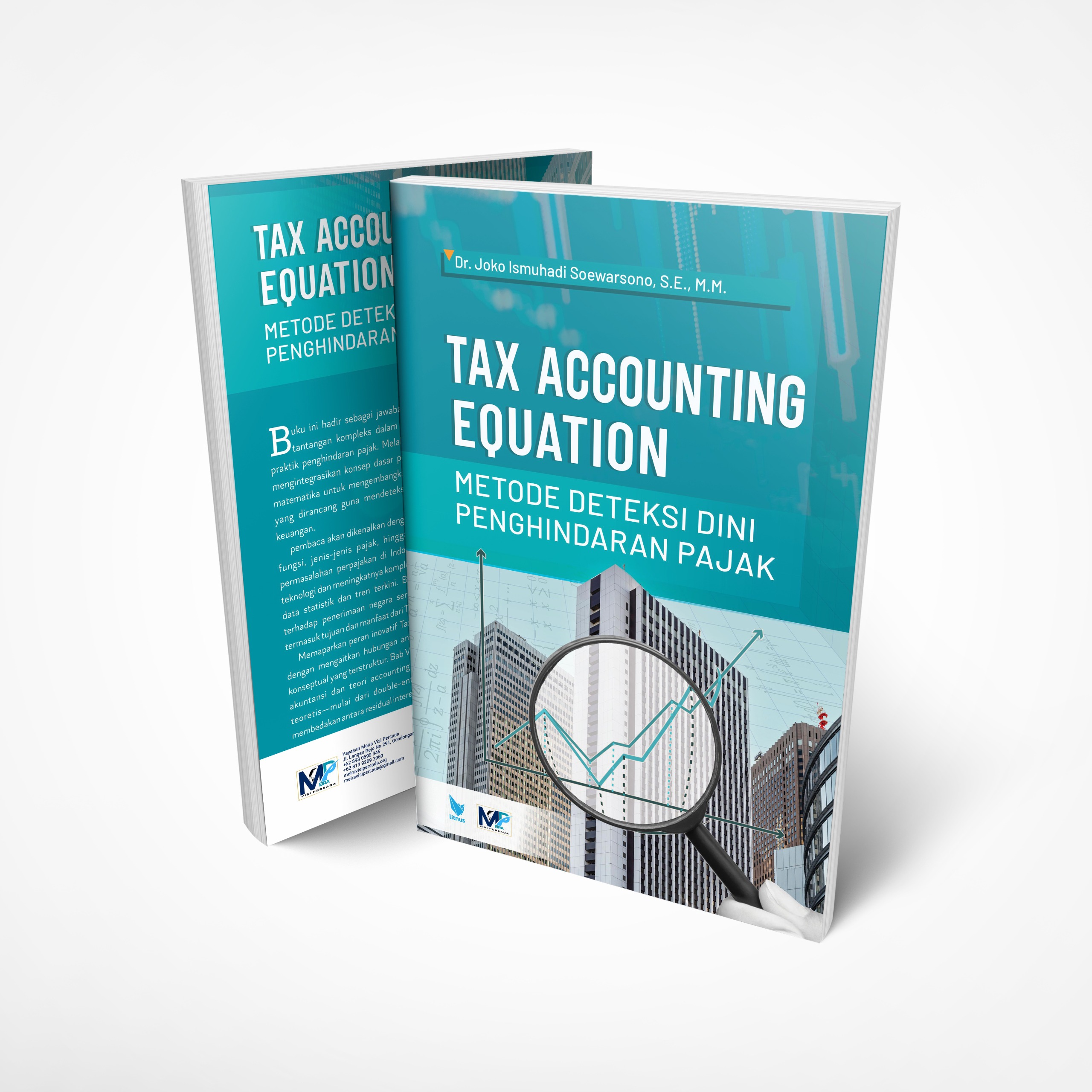
Jakarta, fiskusnews.com:
Introduction: Unveiling Ismuhadi’s Equation (The Tax Accounting Equation)
The escalating global challenge of tax avoidance poses a significant threat to the fiscal stability of nations, particularly in emerging economies. The ingenuity employed by multinational corporations and high-net-worth individuals to minimize their tax obligations necessitates the continuous development and implementation of innovative detection methodologies. In this context, the work of Joko Ismuhadi Soewarsono, an Indonesian tax specialist and academic, stands out as a notable contribution. His career uniquely bridges the practical aspects of tax administration with the rigor of academic research, positioning him as a credible voice in proposing novel solutions to the intricate issue of tax avoidance. This report aims to provide a comprehensive analysis of his Tax Accounting Equation (TAE), a model designed to enhance both tax detection and planning capabilities within the Indonesian context. The subsequent sections will delve into the definition, application, origin, limitations, related concepts, variations, and overall significance of this innovative equation.
Defining the Tax Accounting Equation (TAE): A Novel Analytical Tool
At the core of Joko Ismuhadi Soewarsono’s contribution to the field of taxation is the development and promotion of the Tax Accounting Equation (TAE). This innovative mathematical model serves as an analytical tool for examining taxpayer financial statements, with the primary objective of the early detection of potential tax avoidance and/or embezzlement. The TAE is presented in three interrelated mathematical forms:
- Revenue – Expenses = Assets – Liabilities
- Revenue = Expenses + Assets – Liabilities
- Revenue = Expenses + Equity
These three forms, while mathematically equivalent, offer distinct perspectives for analyzing the financial health and tax compliance of an entity. The components of the TAE are fundamental accounting elements: Revenue represents the income generated from a company’s operations, Expenses are the costs incurred in generating that revenue, Assets are the economic resources owned by the company, and Liabilities represent the company’s obligations to external parties. The TAE specifically focuses on the relationship between a company’s profitability, as reflected in its income statement (Revenue and Expenses), and its financial position, as shown in its balance sheet (Assets and Liabilities). By analyzing this relationship, tax authorities can potentially identify inconsistencies that might indicate tax avoidance or other financial irregularities. The equation aims to reveal imbalances that deviate from expected financial relationships, thereby flagging potential areas for further scrutiny.
The TAE is not a completely novel concept but rather a derivation and adaptation of established accounting principles. It is rooted in the fundamental accounting equation, which posits that Assets = Liabilities + Equity. This basic equation underscores the balance between a company’s resources and its sources of funding. The expanded accounting equation, which further details the components of equity, is expressed as Assets = Liabilities + Equity + (Revenues – Expenses – Dividends/Withdrawals). This expansion illustrates how a company’s operational activities (Revenues and Expenses) and distributions to owners (Dividends/Withdrawals) impact its equity. For the purpose of tax analysis, particularly in scenarios where taxable income might be manipulated, Mr. Soewarsono formulated the TAE by rearranging and focusing on the direct relationship between the income statement and the balance sheet. This derivation highlights a strategic shift in focus from the traditional emphasis on equity to a direct comparison of income statement and balance sheet elements for tax scrutiny. It suggests that Soewarsono recognized a potential gap in traditional accounting analysis when specifically applied to the detection of tax avoidance. Traditional accounting equations primarily ensure the balance of the balance sheet and track changes in equity. Soewarsono’s TAE reconfigures these elements to directly compare the outcomes of operations (profitability) with the resulting net asset position, making it potentially easier to spot discrepancies indicative of tax manipulation. Furthermore, the three forms of the TAE offer flexibility in analysis. The first form (Revenue – Expenses = Assets – Liabilities) directly links profitability to net assets, while the second form (Revenue = Expenses + Assets – Liabilities
or the three form
Revenue = Expenses + Equity
) emphasizes the sufficiency of revenue to cover costs and contribute to net asset value. Discrepancies in either form can signal potential issues requiring closer examination by tax authorities.
The Domain of Application: Forensic Tax Accounting in Indonesia
The Tax Accounting Equation developed by Joko Ismuhadi Soewarsono is specifically designed for application within the Indonesian tax system. Indonesia, as an emerging economy, faces unique challenges in ensuring tax compliance and addressing the presence of a significant informal sector. These factors often create opportunities for tax evasion and avoidance that necessitate the development of specialized analytical tools. The TAE serves precisely this purpose, functioning as a forensic accounting tool tailored for the Indonesian tax landscape. Its primary domain of application is the examination of taxpayer financial statements to detect early indications of potential tax avoidance and/or embezzlement. By analyzing the financial data through the lens of the TAE, tax authorities aim to uncover hidden economic activity that might otherwise evade taxation. The specific designation of TAE as a forensic tool and its focus on the Indonesian context suggest that Soewarsono developed this equation to address particular challenges and common tax avoidance schemes prevalent in Indonesia. The Indonesian economic landscape, with its mix of formal and informal sectors, might indeed present unique avenues for tax evasion not as common in more developed economies. Soewarsono’s extensive experience as a tax auditor in Indonesia likely provided him with valuable insights into these specific methods, leading to the creation of a tool specifically tailored to this environment. Moreover, the mention of both tax avoidance and embezzlement as targets for detection indicates that the TAE is intended to identify a broad spectrum of financial irregularities that impact tax liabilities, extending beyond just outright illegal acts of embezzlement to include strategies for legally minimizing tax obligations.
Origin and Derivation: The Work of Joko Ismuhadi Soewarsono
The Tax Accounting Equation is the brainchild of Dr. Joko Ismuhadi Soewarsono, an Indonesian tax specialist and academic whose career uniquely bridges the practical and theoretical aspects of taxation. Dr. Soewarsono’s expertise is rooted in his extensive experience as a tax auditor and supervisor within the Directorate General of Taxes (DGT) of the Republic of Indonesia, coupled with his ongoing doctoral research in both tax accounting and tax law. His involvement with academic associations such as the Association of Tax Centers and Tax Academics of All Indonesia (Pertapsi) and the Association of Indonesian Legal Experts (Perkahi) further underscores his commitment to both the practice and the advancement of tax knowledge. His areas of expertise also encompass critical domains such as financial engineering, corporate finance, valuation, and mergers and acquisitions. Dr. Soewarsono’s dual background as a seasoned tax practitioner and an active academic lends significant credibility to the TAE. His practical experience within the Indonesian tax authority likely provided him with firsthand insights into the common tactics employed for tax avoidance, which in turn informed the development of a tool directly relevant and applicable to real-world tax auditing challenges. The academic perspective ensures the theoretical soundness and rigor of the equation, making it a potentially more effective instrument for tax analysis than a purely theoretical model.
The derivation of the TAE is a logical progression from established accounting principles. As previously mentioned, it is derived from the fundamental accounting equation (Assets = Liabilities + Equity) and the expanded accounting equation (Assets = Liabilities + Owner’s Capital + (Revenues – Expenses – Withdrawals/Dividends)). In formulating the TAE, Dr. Soewarsono strategically focused on the relationship between the income statement, which summarizes revenues and expenses, and the balance sheet, which presents assets and liabilities, specifically for the purpose of tax analysis. The rationale behind this specific formulation lies in its potential to detect manipulations where taxable income is intentionally understated through the misclassification or misreporting of revenues, expenses, assets, or liabilities. This derivation process demonstrates a clear and logical link between the TAE and well-established accounting principles, reinforcing its theoretical foundation and making it a sound approach to tax analysis. By grounding the TAE in fundamental accounting concepts, Dr. Soewarsono ensures that it is not an arbitrary formula but rather a logical extension of existing financial analysis frameworks, potentially facilitating its understanding and adoption by tax authorities and financial professionals.
Dr. Soewarsono’s work on the TAE has been documented in publications such as his paper titled “Tax Accounting Equations: Early Detection of Tax Avoidance,” which he authored as a Senior Tax Auditor at the Large Tax Regional Office of the Directorate General of Taxation, Ministry of Finance of the Republic of Indonesia in 2022. His ongoing PhD research in tax accounting and tax law further supports his scholarly contributions in this area. Furthermore, the TAE has garnered public attention and sparked discussions, particularly on platforms like YouTube, highlighting its potential to modernize traditional accounting methodologies and address tax evasion in Indonesia. The development of the TAE is clearly situated within the context of the Indonesian tax system and the persistent need for more effective tools to combat tax avoidance and enhance revenue collection. The existence of these publications and public discussions suggests a growing recognition of the TAE and its potential as a valuable instrument for tax authorities in Indonesia. While the available material does not point to extensive peer-reviewed publications in international academic journals, the presence of these papers and online discussions indicates a level of dissemination and engagement with the concept within Indonesia.
Practical Applications of the TAE
The Tax Accounting Equation developed by Dr. Joko Ismuhadi Soewarsono has several key applications, particularly for tax authorities in their efforts to identify potential tax evasion. By analyzing the financial statements of taxpayers through the lens of the TAE, tax officers can identify discrepancies and unusual patterns that might suggest intentional misreporting for tax purposes. For instance, the equation can help in spotting instances where revenues might be deliberately understated or expenses overstated, as these manipulations would likely result in an imbalance within the TAE when compared to the asset and liability sides of the financial statements. The TAE can also be instrumental in identifying potentially misleading accounting transactions, such as recording revenues as liabilities or expenses as assets, often through the use of clearing accounts. By highlighting these unusual inverse relationships, the TAE can act as a red flag, prompting tax…source transactions. For example, if a company reports consistently low profitability while simultaneously exhibiting a substantial net asset position, applying the first form of the TAE (Revenue – Expenses = Assets – Liabilities) would reveal a notable imbalance. Similarly, using the second form (Revenue = Expenses + Assets – Liabilities), an unusually low reported revenue in relation to expenses and net assets could raise suspicion of hidden income or misclassification of revenue. The TAE is often portrayed as an early warning system, enabling the detection of potential tax avoidance before it escalates into a major problem. The specific examples of how TAE can be applied provide concrete evidence of its practical utility for tax auditors in identifying various tax avoidance techniques. By focusing on common manipulation tactics like underreporting revenue, inflating expenses, or misclassifying accounts, the TAE offers a targeted approach to identifying red flags in financial statements.
Beyond tax detection, the TAE also has potential applications in tax planning for businesses within Indonesia. While not as explicitly detailed in the provided material, the framework provided by the TAE could assist businesses in understanding the tax implications of different financial decisions. By recognizing the relationships highlighted by the equation, companies might be able to structure their transactions in a more tax-efficient manner while still adhering to tax regulations. Understanding how tax authorities might use the TAE to scrutinize financial statements could incentivize businesses to ensure their reporting accurately reflects their economic activities and avoids potential imbalances that could trigger audits. The TAE is also recognized as a forensic accounting tool for Indonesian tax analysis, emphasizing its utility in scrutinizing financial data to uncover evidence of past tax evasion or financial manipulation.
The TAE is particularly useful in analyzing complex transactions and financial engineering activities often employed by group companies. For instance, Dr. Soewarsono highlights the potential misclassification of income as liabilities by taxpayers as a common strategy for tax avoidance. This strategy can distort the expected equilibrium within the TAE, particularly in the form Revenue = Expenses + Assets – Liabilities, where an unusually high level of liabilities coupled with low reported revenue could suggest such a misclassification. He also points to the potential use of clearing accounts and sophisticated financial engineering techniques, such as back-to-back loans disguised as hedging activities, as mechanisms to facilitate the reclassification of income as non-taxable liabilities. These complex maneuvers can obscure the true nature of financial transactions, making it challenging for tax authorities using conventional methods to detect the underlying tax avoidance. However, by applying the TAE, particularly the second form (Revenue = Expenses + Assets – Liabilities), tax authorities can look for significant deviations from the expected revenue-liability equilibrium, potentially indicating that income has been misclassified as a liability to avoid immediate taxation. The ability of TAE to analyze such complex transactions highlights its potential to address sophisticated tax avoidance strategies employed by larger corporations and multinational entities operating in Indonesia. Financial engineering often involves intricate arrangements that can be difficult to unravel using traditional audit methods. The TAE’s focus on fundamental financial relationships provides a framework for identifying potential anomalies even within complex transaction structures.
Limitations, Assumptions, and Considerations
While the Tax Accounting Equation presents a promising tool for enhancing tax enforcement in Indonesia, it is important to acknowledge its potential limitations, underlying assumptions, and considerations for its effective application. One key limitation is its dependence on the accuracy and completeness of the financial data being analyzed. The effectiveness of the TAE, like any analytical tool relying on reported financial information, is inherently tied to the integrity of that data. If companies deliberately falsify or omit financial information, the TAE might not reveal the underlying tax avoidance. For instance, sophisticated tax evasion schemes might involve creating fictitious transactions or manipulating asset valuations in ways that do not necessarily lead to obvious imbalances within the core relationships defined by the TAE. In such cases, more in-depth forensic accounting techniques and investigations might be required to uncover the fraudulent activities.
Furthermore, the effective application and interpretation of the TAE necessitate the involvement of skilled tax auditors with a robust understanding of accounting principles. The equation itself provides a framework for analysis, but the ability to discern between legitimate business reasons for financial statement imbalances and those indicative of potential tax avoidance rests on the expertise and professional judgment of the auditors. An imbalance flagged by the TAE might have a valid explanation related to the specific industry, business model, or economic circumstances of the taxpayer. Auditors need to be equipped to investigate these imbalances thoroughly and determine whether they are indeed indicative of tax avoidance or have a legitimate business rationale. The TAE, therefore, is not a substitute for human expertise but rather a tool that augments the capabilities of skilled tax professionals.
Another consideration is the potential for highly sophisticated tax avoidance techniques to circumvent the analysis provided by the TAE. While the TAE is designed to detect common methods of tax manipulation, companies engaged in the most advanced forms of tax avoidance might employ strategies that do not result in the types of imbalances that the equation is specifically designed to identify. Such techniques might involve exploiting loopholes in tax laws, utilizing complex offshore structures, or engaging in intricate transfer pricing arrangements that require more specialized analytical approaches beyond the scope of the TAE alone. In these instances, tax authorities might need to employ a combination of tools and techniques, including detailed forensic audits and international collaboration, to effectively address the tax avoidance.
Finally, it is worth noting that the available research material does not explicitly mention formal academic peer-reviewed publications or rigorous empirical testing of the TAE’s effectiveness in detecting tax avoidance. This could suggest that the TAE is a relatively new concept or one that is primarily focused on practical application within the Indonesian tax authority, rather than having undergone extensive academic validation in the broader international context. While the theoretical basis of the TAE is sound, rooted in fundamental accounting principles, further research and empirical studies would contribute to a more comprehensive understanding of its effectiveness, limitations, and potential for broader adoption.
Related Concepts and Theories
Understanding the Tax Accounting Equation requires a grasp of the foundational concepts upon which it is built. The most fundamental of these is the basic accounting equation: Assets = Liabilities + Equity. This equation represents the cornerstone of double-entry bookkeeping and illustrates the fundamental balance between a company’s resources (assets) and the sources of those resources (liabilities and equity). Liabilities represent obligations to external parties, while equity represents the owners’ stake in the company. Expanding upon this is the expanded accounting equation: Assets = Liabilities + Equity + (Revenues – Expenses – Dividends/Withdrawals). This form details how a company’s operating activities (revenues and expenses) and distributions to owners (dividends or withdrawals) impact its equity. The TAE builds upon these foundational equations by rearranging and focusing on the specific relationships between revenues, expenses, assets, and liabilities that are particularly relevant for tax analysis. It essentially shifts the focus from the traditional emphasis on equity to a more direct examination of the relationship between profitability and net asset position in the context of potential tax avoidance.
Another related concept crucial to understanding the application of the TAE is financial engineering. Financial engineering involves the design and development of innovative financial instruments and processes to solve complex financial problems and exploit opportunities. In the context of taxation, financial engineering techniques can be integral to the implementation of advanced tax planning strategies, often involving intricate transaction schemes aimed at optimizing tax outcomes. These strategies can sometimes involve complex maneuvers designed to reclassify income or inflate expenses to minimize tax liabilities. The TAE is specifically designed to scrutinize the outcomes of such financial engineering activities that might be aimed at tax avoidance, such as the misclassification of income as liabilities through instruments like back-to-back loans disguised as hedging activities. By focusing on the fundamental relationships between financial statement elements, the TAE aims to bring transparency to potentially opaque transactions resulting from financial engineering and identify discrepancies that could indicate tax avoidance.
Variations of the Tax Accounting Equation
As previously discussed, the Tax Accounting Equation is presented in two primary forms, which can be considered variations of each other, each offering a slightly different analytical perspective :
- Revenue – Expenses = Assets – Liabilities
- Revenue = Expenses + Assets – Liabilities
- Revenue = Expenses + Equity
The first form, Revenue – Expenses = Assets – Liabilities, directly compares a company’s profitability, as represented by the difference between its revenue and expenses, with its net worth, calculated as the difference between its assets and liabilities. The underlying logic is that a company’s operational profitability should ultimately contribute to its net asset position. Significant imbalances in this equation, such as a company reporting low profitability despite possessing substantial net assets, could potentially indicate manipulations aimed at reducing taxable income, such as underreporting revenue or inflating expenses.
The second form, Revenue = Expenses + Assets – Liabilities, emphasizes that a company’s revenue should be sufficient to cover its operating expenses and contribute to its overall net asset value. In this formulation, an unusually low level of reported revenue in relation to the company’s expenses and net assets could raise suspicion of hidden income or the misclassification of revenue as liabilities to avoid immediate taxation. For example, Dr. Soewarsono suggests that taxpayers might intentionally misclassify revenue as liabilities, thereby distorting the expected balance in this form of the TAE and obscuring their true financial performance.
And the three form, Revenue = Expenses + Equity
The rearrangement of the basic relationship into these two forms provides flexibility in analysis, allowing auditors to focus on different aspects of financial reporting that might be susceptible to manipulation for tax avoidance purposes. Depending on the specific tax avoidance scheme being employed, one form of the TAE might be more effective at detecting the imbalance than the other. Having both forms in the analytical toolkit enhances the likelihood of identifying potential issues in a company’s financial statements that warrant further investigation from a tax perspective.
Significance and Impact within the Indonesian Tax Landscape
The Tax Accounting Equation developed by Joko Ismuhadi Soewarsono holds significant potential for influencing tax policy innovation and administration within Indonesia. By offering a novel, data-driven approach to identifying potential tax evasion and avoidance through the analysis of key financial statement components, the TAE can provide tax authorities with valuable insights into the patterns and methods employed by tax evaders. These insights could, in turn, lead to the development of more targeted and effective tax policies and enforcement strategies. Given Dr. Soewarsono’s background as a tax auditor and supervisor within the Directorate General of Taxes (DGT), there is a strong possibility that his research and the TAE could be considered for adoption or to influence internal practices within the DGT. His direct experience with the challenges of tax administration provides a practical context for his academic work, making his proposed solutions potentially more relevant and implementable within the existing framework.
The TAE also aligns with Indonesia’s ongoing tax reforms aimed at improving tax compliance, increasing state revenue, and addressing the issue of the underground economy. By offering a new tool for forensic accounting that can help identify high-risk cases and potentially uncover sophisticated tax avoidance schemes and hidden economic activity, the TAE can contribute to these broader objectives. By providing a framework for early detection of potential tax irregularities, the TAE could lead to a more efficient allocation of audit resources, allowing tax authorities to focus their efforts on taxpayers exhibiting red flags according to the equation. This could ultimately result in increased tax revenue for the government. The potential impact extends beyond just increasing revenue; by promoting greater financial transparency and accountability among taxpayers, the TAE could contribute to a fairer and more equitable tax system in Indonesia. Public discussions surrounding the TAE also underscore its perceived potential in enhancing financial transparency and combating tax evasion.
In conclusion, the Tax Accounting Equation represents a significant and dynamic contribution to the ongoing discourse on financial and corporate governance in Indonesia. Its potential to modernize traditional accounting methodologies for improved tax detection and planning makes it a valuable tool in the fight against tax evasion and in the pursuit of a more robust and equitable tax system within the nation.
Conclusion: The Role of Ismuhadi’s Equation in Modernizing Indonesian Tax Analysis
The Tax Accounting Equation (TAE), developed by Dr. Joko Ismuhadi Soewarsono, stands as a significant innovation in the field of forensic tax accounting, particularly within the Indonesian context. This novel analytical tool, derived from fundamental accounting principles, offers tax authorities a data-driven approach to identifying potential tax avoidance and embezzlement by scrutinizing the relationships between key financial statement components. Its two primary forms provide flexibility in analysis, allowing for the detection of various manipulation tactics aimed at understating taxable income. While the effectiveness of the TAE is contingent upon the accuracy of financial data and the expertise of tax auditors, its potential to enhance tax detection, inform policy, increase revenue, and promote financial transparency within Indonesia is substantial. Continued research and the potential adoption of the TAE by the Directorate General of Taxes could represent a significant step towards modernizing tax analysis and enforcement in Indonesia, ultimately contributing to a more robust and equitable fiscal environment.
Key or Valuable Tables:
Table 1: Forms of Ismuhadi’s Equation (Tax Accounting Equation)
| Form | Analytical Focus |
|---|---|
| Revenue – Expenses = Assets – Liabilities | Direct comparison of a company’s profitability (Revenue – Expenses) with its net worth (Assets – Liabilities) to detect potential underreporting of income or inflated expenses, indicated by significant imbalances. |
| Revenue = Expenses + Assets – Liabilities | Assessment of whether a company’s revenue is sufficient to cover its operating expenses and contribute to its overall net asset value. Unusually low revenue relative to expenses and net assets can highlight potential hidden income or the misclassification of revenue as liabilities to avoid immediate taxation. |
Reporter: Marshanda Gita – Pertapsi Muda
Share
Berita Lainnya
Persamaan Akuntansi Pajak Dr. Joko Ismuhadi: Pendekatan Baru untuk Mendeteksi Penyimpangan Keuangan di Indonesia
KOMISI (Kelas Online akadeMISI) Seri Pemeriksaan Pajak Episode 5 bertajuk Pemeriksaan Bukti Permulaan & Penyidikan Pajak
Al Capone Attorney: Legacy Easy Eddy
Mengungkap Aktivitas Ekonomi Bawah Tanah di Indonesia
Rekomendasi untuk Anda

Berita Terbaru
Eksplor lebih dalam berita dan program khas fiskusnews.com
Tag Terpopuler
# #TAE
# #TAX ACCOUNTING EQUATION
# #TAX FRAUD
# #TAX EVASION


